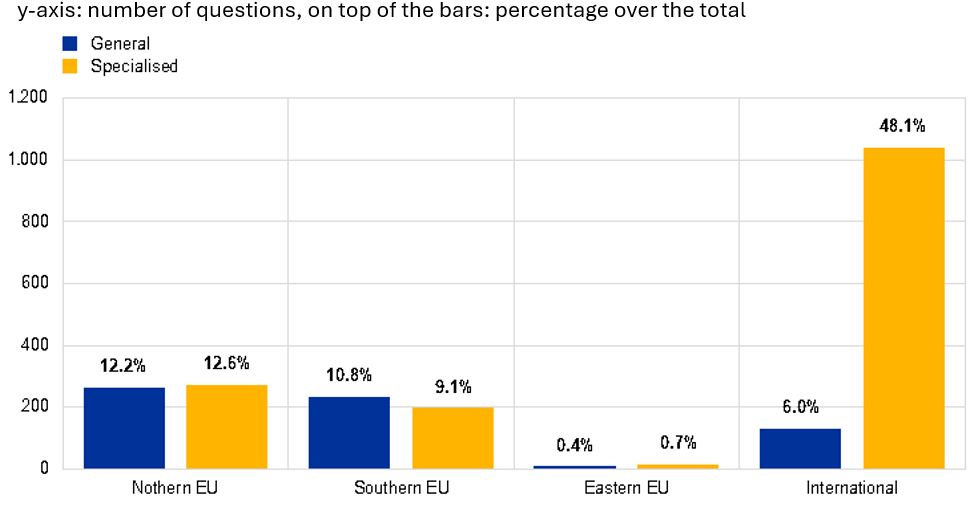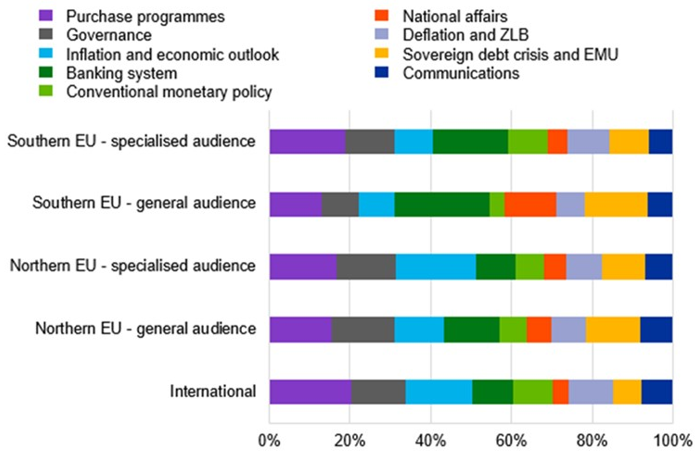

Disclaimer: This Policy Brief is based on European Central Bank Working Paper Series No. 2852. The views expressed are those of the authors and do not necessarily reflect those of the ECB.
News media play a fundamental role in the communication between central banks and the public. To better understand how this intermediation process works, this brief explores the Q&A session of the European Central Bank (ECB)’s press conferences, where journalists have an opportunity to set the discussion and inquire into the central bank’s thinking. Using text analysis, we conduct a systematic examination of the topics the ECB is questioned about and uncover differences in the focus of outlets from different geographical areas of Europe and with different types of audiences. International outlets devote more attention to technical topics, relevant for market participants, while domestic media in the European Union dedicate greater focus to national affairs and the more political dimensions of the ECB’s activities.
Communication has become a key factor for the transmission of a central bank’s policies. Central banks exercise a profound influence on what occurs in the economy through what they say. Commercial banks and financial institutions hang on to their every word to gather clues on the direction of monetary policy, as these decisions affect their financing conditions and by extension the economy. The wider public, on the other hand – which is certainly not less affected by monetary policy decisions – follows the communication of central banks indirectly, if at all.
This is where the news media enters the picture. Journalists select and condense information about the activities of central banks in a way that is consumable for their readers, that is, members of the public. To the extent that the public engages with the activities of a central bank, it is generally through following the news as opposed to the communications material of a central bank. Media coverage thus plays a key role in influencing what the public thinks about monetary policy, and even whether it thinks about it at all.1
The press conference is the one forum the ECB regularly offers journalists where they can pose questions directly. Eight times a year – immediately after the policy meetings of the Governing Council – the ECB President and the Vice-President are available to answer questions from the media. The Q&A part of the press conference lasts usually 30 to 45 minutes, during which around 10 journalists get the chance to ask questions. Once they get the floor, the selected journalists are free to ask what they consider appropriate and most interesting.
Press conferences are closely followed by newspapers, TV and news wires, and form the basis upon which other media develop their own comments and coverage of the ECB’s activities.
The remainder of the brief outlines who is offered the questions at the press conference, the variety of topics raised, as well as the overall geographic distribution of questions.
Chart 1 summarises where questions came from across a ten-year period between May 2012 and July 2022. All in all, President Christine Lagarde and her predecessor Mario Draghi answered a total of 2,166 questions posed by 266 journalists representing 124 media outlets.
The lion’s share of these more than 2,000 questions was posed by international media specialising in economic coverage like the Financial Times, Bloomberg, CNBC, Reuters and The Wall Street Journal. Within the European Union, northern and southern EU outlets asked roughly equal shares of questions (25% and 20%, respectively), while enquiries from eastern EU media accounted for only 1% of the total.

Sources: Angino and Robitu (2023).
To group the questions into topics, we used structural topic modelling (STM). STM is a well-known technique in text analysis. It is based on the idea that each text – in our case each question – is a mixture of different topics, with each topic being a distribution of words. It is then up to the researcher to evaluate what the clusters of words represent and accordingly assign them a label.
We identified nine recurring topics among the journalists’ questions, only a portion of which actually concern monetary policy. The topics that do relate to the core of the ECB’s activities include “Conventional monetary policy”, “Purchase programmes”, “Inflation and economic outlook” and “Deflation and Zero Lower Bound (ZLB)”. Another frequent topic revolves around the “Banking System”, related to keywords such as the state of the banking union, European banking supervision, and even more specific issues: for instance, non-performing loans, and even the situation of individual banks.
Some questions concern past and potential future crises threatening the viability of the monetary union, and the reversibility of the euro. They are captured by the topic “Sovereign debt crisis and European Monetary Union (EMU).” Unsurprisingly, questions falling under this topic were especially prominent between 2012 and 2015, in the midst of the euro area’s slow recovery from the Global Financial Crisis.
“National affairs” captures questions on the economic, financial, and political affairs of Member States. This topic pertains to structural reforms and fiscal policy within countries, as well as issues on which the ECB cannot comment, such as national elections or referenda.
We also found two topics connected to the internal processes of the ECB. The first is “Governance”, which mainly regards the Governing Council deliberations, including the unanimity, or lack thereof, in their decisions. Other issues captured by this topic are legal ones. For instance, the rulings of the German Federal Constitutional court on the compatibility of various ECB programmes with German law (like in 2013 or in 2020). The second operational topic is “Communications”. This topic includes references to forward guidance, a monetary policy tool used by the ECB to provide information about its future monetary policy intentions in the era of ultra-low policy rates, but also comprises words like “announcement”, “signal” and “minutes”. This, in our view, is evidence of the increasing interest in central bank communications since the Global Financial Crisis.
The next question is: do journalists from different parts of the euro area and the world ask about the same topics? And do questions from outlets catering for general audiences differ from those for expert audiences?
After having identified the nine topics in the questions, we move onto the differences across media types. We consider five outlet groups: “Northern EU – general audience”, “Northern EU – specialised audience”, “Southern EU – general audience”, “Southern EU – specialised audience”, and “International”. Virtually all outlets in the international group specialise in economics and finance so there is no need to differentiate audiences.
What do we find? First, international media tend to focus on technical topics related to monetary policy more than national outlets. In Chart 2, these are the topics like “Purchase programmes”, “Conventional monetary policy”, and “Deflation and ZLB” – more pertinent for expert audiences than the wider public.

Sources: Angino and Robitu (2023).
At the same time, international outlets ask very little about national affairs. The share of their questions that these outlets devote to the topic is 8 percentage points smaller than the equivalent share for national media targeting the wider public, in both the Northern and Southern EU groups. This finding suggests that general audiences are more interested in national affairs than in abstract and technical areas of the ECB’s activities like unconventional monetary policy.
The sovereign debt crisis (yellow in the chart) also features more in the questions of general audience outlets. This topic is especially prominent in Southern EU outlets.
The “Banking System” topic (dark green in the chart) is also very salient in the South. In fact, outlets in that region devote a share of their questions to this topic that is between 8 and 14 percentage points larger than that devoted by outlets elsewhere. This appetite for banking supervision topics squares with evidence from other research on the matter. Why might this be? While this is beyond the scope of our analysis, the banking crises of recent decades and the subsequent reforms in Europe’s south may be an important clue.
Coverage of the “Governance” and “Communications” topics, meanwhile, does not change much across different media spheres.
What about differences between general and specialised audience outlets? They are especially important in the Southern EU group. Specialised outlets in the South tend to be quite similar to international outlets. In the Northern EU group, however, the most sizeable difference is in the “Inflation and economic outlook” topic (light blue). The share of their questions that specialised outlets devote to this topic is 8 percentage points larger than the share devoted to it by general outlets.
When they have the chance, journalists don’t just ask the ECB about its monetary policy. They often stray into topics well beyond what is usually considered the main role of a central bank. What exactly they focus on depends on their geographical scope and the type of audience they cater to.
Outlets targeting the wider public want to focus on more domestic, political and vivid issues that attract the public’s interest. So, the ECB faces a trade-off. By granting questions to these outlets, it can broaden the discussion and speak on topics close to citizens’ hearts. The risk, on the other hand, is being confronted with sensitive issues lying beyond the scope of its mandate.
Angino, Siria, and Robert Robitu. “One question at a time! A text mining analysis of the ECB Q&A session”, ECB Working Paper Series No. 2852 (2023).
Assenmacher, Kahtrin et al. “Clear, consistent and engaging: ECB monetary policy communication in a changing world”, ECB Occasional Paper Series No 274 (2021).
Binder, Carola. “Federal Reserve Communication and the Media”, Journal of Media Economics 30(4) 2017a.
Blinder, Alan S., Michael Ehrmann, Jakob De Haan, and David-Jan Jansen. “Central bank communication with the general public: Promise or false hope?”, ECB Working Paper Series 2694 (2022).
Ehrmann, Michael and Marcel Fratzscher. “Explaining Monetary Policy in Press Conferences”, ECB Working Paper Series No 767 (2007).
According to the ECB’s most recent public opinion survey (the Knowledge and Attitudes survey), whose fieldwork took place in Autumn 2022, 75% of respondents in the euro area have heard about the ECB on television, 45% via printed press, 40% via online press, 37% on radio, and 29% via at least one social media platform.
Italian proverb referring to how different countries have different customs, broadly equivalent to “when in Rome, do as the Romans do”.